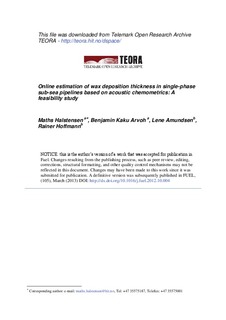| dc.contributor.author | Halstensen, Maths | |
| dc.contributor.author | Arvoh, Benjamin Kaku | |
| dc.contributor.author | Amundsen, Lene | |
| dc.contributor.author | Hoffmann, Rainer | |
| dc.date.accessioned | 2014-03-24T14:35:17Z | |
| dc.date.accessioned | 2017-04-19T12:50:00Z | |
| dc.date.available | 2014-03-24T14:35:17Z | |
| dc.date.available | 2017-04-19T12:50:00Z | |
| dc.date.issued | 2012-10-25 | |
| dc.identifier.citation | Halstensen, Maths, Arvoh, Benjamin Kaku, Amundsen, Lene, & Hoffmann, Rainer. (2013). Online estimation of wax deposition thickness in single-phase sub-sea pipelines based on acoustic chemometrics: A feasibility study. Fuel 105 (2013) March, s. 718-727 | |
| dc.identifier.issn | 1890-1328 | |
| dc.identifier.uri | http://hdl.handle.net/11250/2438439 | |
| dc.description.abstract | Wax deposition in sub-sea oil producing pipelines is a concern to the oil producing companies. The deposition of wax in pipelines can cause serious economic implications if not monitored and controlled. Several researchers have developed models and investigated the deposition of wax in crude oil pipelines. As of today, there is no off the shelf instrument available for reliable online estimation of the wax depo- sition thickness in sub-sea pipelines. Acoustic chemometrics was applied to investigate the potential for online estimation of wax deposition thickness in sub-sea pipelines. This feasibility study was carried out as a so called piggy back on experiments performed at Statoil research centre in Porsgrunn, Norway with real crude oil or waxy gas condensate. The first investigations focused on the repeatability of the acoustic chemometric technique followed by online prediction of the wax deposition thickness in a single-phase oil flow pipeline. A partial least squares regression model was calibrated and validated with a totally independent data set. The calibrated model had a root mean squared error of prediction of 0.28 mm with a final wax deposition thickness of 3.36 mm, a slope of 0.91 and R2 of 0.83 which were satisfactory results. The effect of varying oil flow rates on the wax deposition thickness was also investigated. The preliminary results showed the need for further investigations based on a robust experimental design and sample pre-processing. The general conclusion that can be drawn from this feasibility study was that the potential of adapting the acoustic chemometric technique for online estimation of the wax deposition thickness exist and must be further investigated. | |
| dc.language.iso | eng | |
| dc.publisher | Elsevier | |
| dc.subject | Acoustic chemometrics | |
| dc.subject | Wax deposition | |
| dc.subject | Single-phase flow | |
| dc.subject | Partial least-square regression (PLS-R) | |
| dc.subject | Principal component analysis (PCA) | |
| dc.title | Online estimation of wax deposition thickness in single-phase sub-sea pipelines based on acoustic chemometrics: A feasibility study | |
| dc.type | Journal article | |
| dc.type | Peer reviewed | |
| dc.description.version | Accepted version | |
| dc.subject.nsi | 560 | |
| dc.identifier.doi | http://dx.doi.org/10.1016/j.fuel.2012.10.004 | |
